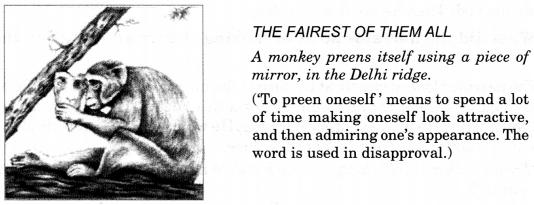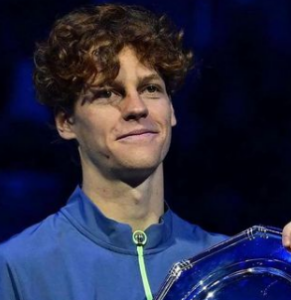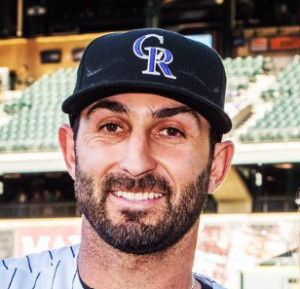NCERT Class 9 English Beehive Chapter 5 Solutions
TEXTBOOK EXERCISES
(Page 60)
THINKING ABOUT THE TEXT
I. Discuss in pairs and answer each question below in a short paragraph (30-40 words).
1. “The sound was a familiar one.” What sound did the doctor hear ? What did he think it was ? How many times did he hear it ? (Find the places in the text.) When and why did the sounds stop ?
2. What two “important” and “earth-shaking” decisions did the doctor take while he was looking into the mirror ?
3. “I looked into the mirror and smiled,” says the doctor. A little later he says, “I forgot my danger and smiled feebly at myself.” What is the doctor’s opinion about himself when (i) he first smiles, and (ii) he smiles again ? In what way do his thoughts change in between, and why ?
Answers
1. The doctor heard a chirping sound. It was the sound of the rats. The doctor heard the sound four times. The phrases are : ‘Again I heard that sound from above’. ‘Again came that noise from above’; ‘Suddenly there came a dull thud as if a rubber tube had fallen…’.
The sounds stopped after the rats saw a snake as they got afraid of him.
2. One, he would shave daily. Second, he would grow a thin moustache to look more handsome. Third, he would always keep that attractive smile on his face.
3. The doctor’s opinion about himself was good that he had an attractive smile when he first smiled. But when he smiled a little later, he pitied himself. It was because he saw his death quite near when the snake was so near his face. His feeble smile indicated his nervousness.
His thoughts changed in between. When he smiled first, there was no danger to his life. But when he saw the snake coiling his arm and very near his face, his thoughts changed. Both of joy and happiness changed into fear and death.
II. This story about a frightening incident is narrated in a humorous way. What makes it humorous ? (Think of the contrasts it presents between dreams and reality. Some of them are listed below).
1. (i) The kind of person the doctor is (money, possessions)
(ii) The kind of person he wants to be (appearance, ambition)
2. (i) The person he wants to marry (ii) The person he actually marries
3. (i) His thoughts when he looks into the mirror
(ii) His thoughts when the snake is coiled around his arm
Write short paragraphs on each of these to get your answer.
Answers
1. (i) The doctor is a poor person. He has hardly any money. He lives in an unelectrified
house. It is a small rented room with plenty of rats living in it. He has just started his medical practice. He had about sixty rupees in his suitcase. He had only one black coat. Besides, he had some shirts and dhotis. So he is not a man of possessions or money.
(ii) The doctor wants to be rich. He also would like to have a good appearance. That’s why he decides to grow a thin moustache.
2. (i) The doctor wants to marry a woman doctor. He wants that she should have a good medical practice and a lot of money. She should be fat as not to run after him and catch him.
(ii) He marries a thin reedy woman. She has the gift of a sprinter.
3. (i) His thoughts are full of joy and satisfaction. He decides to grow a thin moustache and keep smiling always. He finds his smile attractive.
(ii) He turned to stone. He sat like a stone image in the flesh. However, his mind was very active. He felt the great presence of the Creator. He decided to write the words ‘O God’ outside his little heart.
THINKING ABOUT LANGUAGE
I. Here are some sentences from the text. Say which of them tell you, that the author :
(а) was afraid of the snake,
(b) was proud of his appearance,
(c) had a sense of humour,
(d) was no longer afraid of the snake.
- I was turned to stone.
- I was no mere image cut in granite.
- The arm was beginning to be drained of strength.
- I tried in my imagination to write in bright letters outside my little heart the words, ‘O God’.
- I didn’t tremble. I didn’t cry out.
- I looked into the mirror and smiled. It was an attractive smile.
- I was suddenly a man of flesh and blood.
- I was after all a bachelor, and a doctor too on top of it!
- The fellow had such a sense of cleanliness … ! The rascal could have taken it and used it after washing it with soap and water.
- Was it trying to make an important decision about growing a moustache or using eye shadow and mascara or wearing a vermilion spot on its forehead ?
Answers
The following sentences tell that the author (a) was afraid of the snake :
(1), (3), (4), (5)
The following sentences tell that he (b) was proud of his appearance :
(б), (8)
The following sentences tell that (c) he had a sense of humour :
(9), (10)
The following sentences tell that (d) he was no longer afraid of the snake :
(2), (7)
II. Expressions used to show fear
Can you find the expressions in the story that tell you that the author was frightened ? Read the story and complete the following sentences.
- I was turned ……….. .
- I sat there holding ……. .
- In the light of the lamp I sat there like …….. .
Answers
- I was turned to stone.
- I sat there holding my breath.
- In the light of the lamp I sat there like a stone image in the flesh.
III. In the sentences given below some words and expressions are italicised. They are variously mean that one
- is very frightened.
- is too scared to move.
- is frightened by something that happens suddenly.
- makes another feel frightened.
Match the meanings with the words/expressions in italics, and write the appropriate meaning next to the sentence. The first one has been done for you.
- I knew a man was following me, I was scared out of my wits, (very frightened)
- I got a fright when I realised how close I was to the cliff edge.
- He nearly jumped out of his skin when he saw the bull coming towards him.
- You really gave me a fright when you crept up behind me like that.
- Wait until I tell his story – it will make your hair stand on end.
- Paralysed with fear, the boy faced his abductors.
- The boy hid behind the door, not moving a muscle.
Answers
- I knew a man was following me, I was scared out of my wits, (very frightened)
- I got a fright when I realized how close I was to the cliff edge, (too scared to move).
- He nearly jumped out of his skin when he saw the bull coming towards him. (frightened by something that happens suddenly)
- You really gave me a fright when you crept up behind me like that, (make another feel frightened)
- Wait until I tell his story – it will make your hair stand on end. (too scared to move)
- Paralysed with fear, the boy faced his abductors, (very frightened)
- The boy hid behind the door, not moving a muscle, (too scared to moire)
IV. Reported questions
Report these questions, using if!whether or why/when/where!how/which/what. Remember the italicised verbs change into the past tense.
- Meena asked her friend, “Do you think your teacher will come today ?”
- David asked his colleague, “Where will you go this summer ?”
- He asked the little boy, “Why are you studying English ?”
- She asked me, “When are we going to leave ?”
- Pran asked me, “Have you finished reading the newspaper ?”
- Seema asked her, “How long have you lived here ?”
- Sheila asked the children, “Are you ready to do the work ?”
Answers
- Meena asked her friend if he (she) thought his (her) teacher would come that day.
- David asked his colleague where he would go that summer.
- He asked the little boy why he was studying English.
- She asked me when they were going to leave.
- Pran asked me if I had finished reading the newspaper.
- Seema asked her how long she had lived there.
- Sheila asked the children if they were ready to do the work.
DICTATION
The following paragraph is about the Indian cobra. Read it twice and close your book. Your teacher will then dictate the paragraph to you. Write it down with appropriate punctuation marks.
The Indian cobra is the common name for members of the family of venomous snakes, known for their intimidating looks and deadly bite. Cobras are recognized by the hoods that they flare when angry or disturbed ; the hoods are created by the extension of the ribs behind the cobras’ heads. Obviously the best prevention is to avoid getting bitten. This is facilitated by the fact that humans are not the natural prey of any venomous snake. We are a bit large for them to swallow whole and they have no means of chopping us up into bite-size pieces. Nearly all snakebites in humans are the result of a snake defending itself when it feels threatened. In general snakes are shy and will simply leave if you give them a chance.
Answer
The Indian Cobra is the common name for members of the family of venomous snakes, known for their intimidating looks and deadly bite. Cobras are recognized by the hoods that they flare when angry or disturbed ; the hoods are created by the extension of the ribs behind the cobra’s heads. Obviously the best prevention is to avoid getting bitten. This is facilitated by the fact that humans are not the natural prey of any venomous snake. We are a bit large for them to swallow whole and they have no means of chopping us up into bite-size pieces. Nearly all snakebites in humans are the result of a snake defending itself when it feels threatened. In general, snakes are shy and will simply leave if you give them a chance.
WRITING
1. Try to rewrite the story without its humour, merely as a frightening incident. What details or parts of the story would you leave out ?
Answer
The Most Frightening Incident
It was a hot summer night. I had been living in a shed made of straw. There was an old table. On it there was a mirror. I was looking in the mirror. Then a snake fell on my shoulder. Before I could do anything, the snake had coiled around my left arm. It was
above the elbow. Its hood was spread out. Its head was hardly three or four inches from my face.
I almost froze with fear. My breath stopped. I was like a stone. I knew if I moved even one centimetre, the snake would sting me. I couldn’t move even a centimetre. I started praying to God. By chance the snake’s eyes fell on its reflection in the mirror. It slowly fell down on my lap.
It then moved on to the table. It started looking at its own reflection in the mirror. I saw that I was breathing. I, at once, jumped off and ran like a mad man. I felt that I was safe. I thanked God greatly.
2. Read the description given alongside this sketch from a photograph in a newspaper. Make up a story about what the monkey is thinking, or why it is looking into a mirror. Write a paragraph about it.
Answer
When a Monkey Got a Mirror
Last month I saw a strange incident about a monkey. Our colony has a lot of them. I saw once that a monkey had got a piece of looking mirror. He was looking into it. He was seeing his own face. But he never thought that it was his. He grinned, chuckled and showed teeth. His reflection also did the same. He thought that there was another monkey around. He searched for him all around. He turned his face around him. Or perhaps he was thinking how beautiful he looked ! He also saw the reflection of other things. He grew more and more interested in the mirror. We also were enjoying his actions of looking at the mirror.
After sometime, another big monkey came. There were two more monkeys. They started fighting. In that the monkey threw the mirror at one of them. It broke into pieces. Each monkey got one piece each. They started repeating the actions of the monkey with a mirror.




